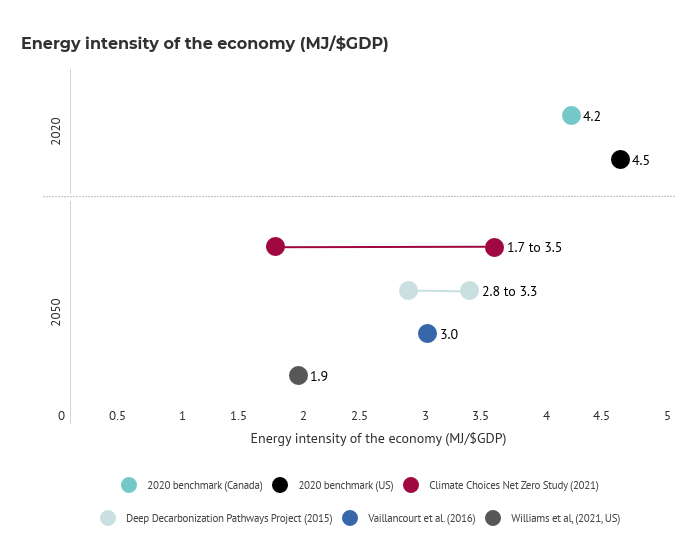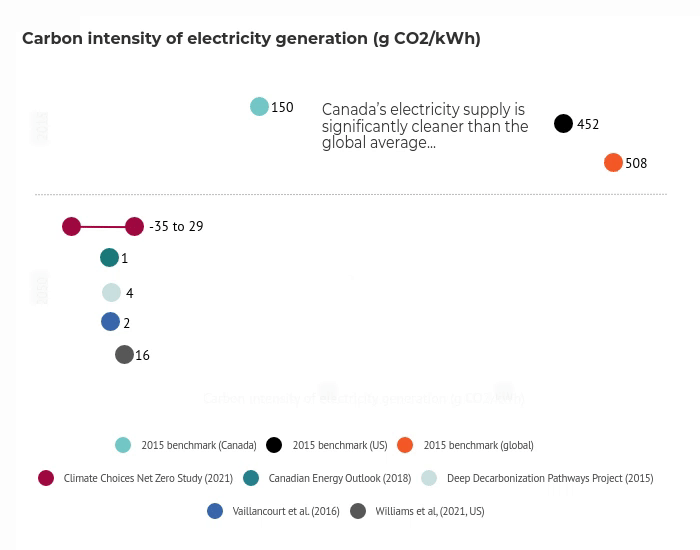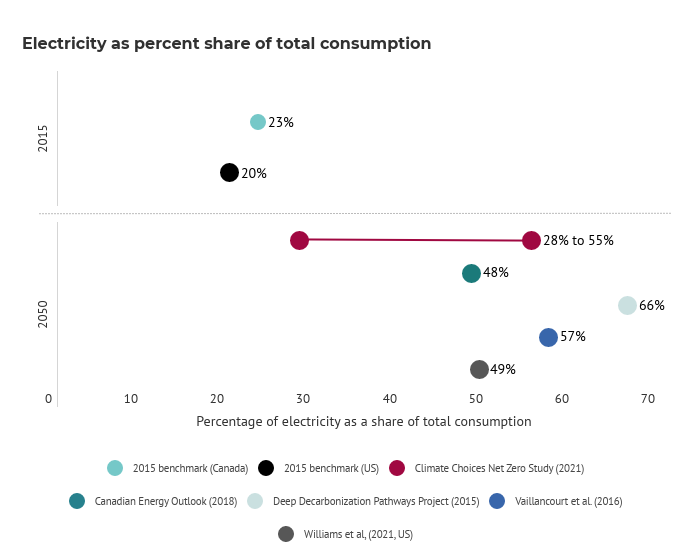At the April 2021 Leaders’ Summit on Climate, the Canadian government announced a new, more ambitious 2030 target: to reduce greenhouse gas emissions by 40 to 45 per cent below 2005 levels. With existing and planned measures set to achieve an estimated 36 per cent reduction in emissions by 2030, it’s not yet clear how Canada will make up the difference.
Our report Canada’s Net Zero Future identifies the “safe bet” solutions governments can and should be advancing now. Now that Canada is working toward even more ambitious reduction targets, getting to 2030 is all about doubling down on these safe bets.
Let’s start with the low-hanging fruit
Our net zero report identified two types of solutions we’ll need to employ to reach net zero: safe bets and wild cards. Wild cards are solutions that are in the early days of technology development, face barriers to scaling up in a big way, or might not outcompete lower-cost solutions even if they do prove technically viable. These solutions could come to play an important role in Canada’s net zero future, but their potential remains uncertain.
Safe bets, on the other hand, are solutions that are already commercially available today, face no major barriers to scaling up, and are expected to come down in cost. Examples include improving energy efficiency, generating cleaner electricity, and using this clean electricity to replace fossil fuels in everyday applications (like switching from gas-powered cars to electric ones). These solutions play a critical role across all the pathways to net zero for Canada, especially in the next decade. Specifically, our analysis (which modelled Canada reaching its previous 2030 target of 30 per cent reductions below 2005 levels) found that safe bets contribute anywhere from two thirds to 90 per cent of emission reductions in 2030.
The significant role for safe bets in the next decade is driven in part by the limited availability of wild cards, which are either still in the early stages of technology development or still too costly to be deployed at scale. As the best options available today, safe bets have to do the heavy lifting to meet Canada’s near-term climate targets. Deploying those solutions even faster and more broadly will be necessary to meet the new, more ambitious 40 to 45 per cent target.
Other studies agree
The Institute’s study of how net zero could be achieved in Canada is not alone in finding that safe bets are critical to achieve deep emissions reductions. Regardless of the path to long-term emissions reduction targets, studies agree that certain measures will be critical, and we must move ahead confidently on them.
The International Energy Agency released a pivotal report in May 2021 that outlined a net zero pathway for the global energy system. It echoes our findings on both the centrality of safe bets and the need for wild cards in the long term. In particular, it states that most short-term emissions reductions need to come from available technology, showing that energy efficiency, non-emitting electricity, and electrification will make critical contributions to reducing emissions by 2030. By 2050, it states that almost half of reductions will come from technologies at earlier stages of development, akin to what we call wild cards.
Regardless of the pathway, achieving deep emissions reductions by mid-century requires shifting to much more energy efficient technologies and practices.
Looking at Canada, the “Trottier Energy Futures Project” (2016), for example, assessed a range of deep emissions reductions scenarios by 2050 and found that certain solutions showed up consistently in the short- and medium-term, including increased energy efficiency and large-scale electrification. The “Deep Decarbonization Pathways Project” (2015) modelled a scenario achieving deep emissions reductions by 2050 and characterized certain pathways as “having a broad and resilient portfolio of technically and economically feasible technologies now” (safe bets, in our terms). These pathways include cleaning up electricity supply, electrifying end uses, and improving energy productivity (linked to energy efficiency). Vaillancourt et al. (2016) show these pathways are the three “dominant fundamental transformations” needed to reach deep reductions by 2050.
Numerous U.S. net zero studies released this year also come to similar conclusions. For instance, the “Accelerating Decarbonization in the United States” (2021) study lists efficiency, electrification, and clean electricity as three out of five key actions that are needed regardless of what the energy system looks like in 2050 and are “robust to uncertainty caused by a future technological breakthrough.” “Carbon-Neutral Pathways for the United States” (2021) lists with “high confidence” certain measures required in the next decade across various pathways, including increasing non-emitting electricity supply, and electrifying passenger vehicles and buildings through EVs and heat pumps.
Though these studies inevitably vary in their assumptions, definitions, and reductions targets, they nonetheless converge on the centrality of safe bets. Below, we unpack how our study compares with others on specific safe-bet solutions.
Energy efficiency as a workhorse
Energy efficiency plays a significant and growing role across all the scenarios in our study, especially in the short term. These gains would be made in every sector—from buildings to cars to industrial processes—and could reduce Canada’s energy intensity (an imperfect but suitable proxy for measuring efficiency). These findings show that, regardless of the pathway, achieving deep emissions reductions by mid-century requires shifting to much more efficient technologies and practices.

Electricity is key
Our study aligns with others on the importance of electricity in driving emissions reductions—both with regards to increasing supply of non-emitting electricity and growing the demand for electricity relative to other fuels. For instance, Canada’s electricity supply is already clean relative to the global average, but in the studies assessed, it is almost (if not fully) decarbonized by 2050.

Boosting the production of non-emitting electricity involves both phasing out emitting sources of electricity (such as fossil fuels that aren’t paired with carbon capture and storage), and growing our supply of non-emitting sources.
Studies also consistently show an increase in the consumption of electricity, both in absolute terms and relative to other fuels, as technologies such as vehicles and home heating technologies are electrified. For instance, electricity consumed as a share of total consumption across all energy types more than doubles by 2050 from today in the studies assessed.

Going big on safe bets
Canada has laudably raised its climate ambition to 2030, though it now leaves a sizable gap between where the country is currently headed and where we need to go. Fortunately, research offers clarity on how to close that gap. Studies agree that safe-bets investments—such as improving energy efficiency and increasing the supply and use of non-emitting electricity—are critical drivers to achieve net zero, especially in the short term. In the face of greater 2030 ambition, Canada can—and should—sharpen its focus on rapidly deploying safe bets.








